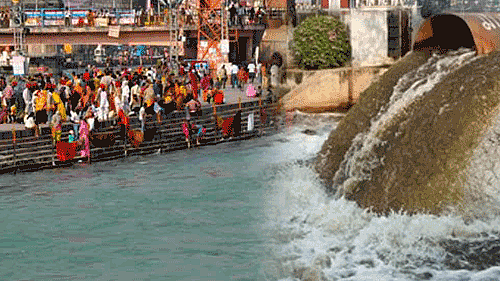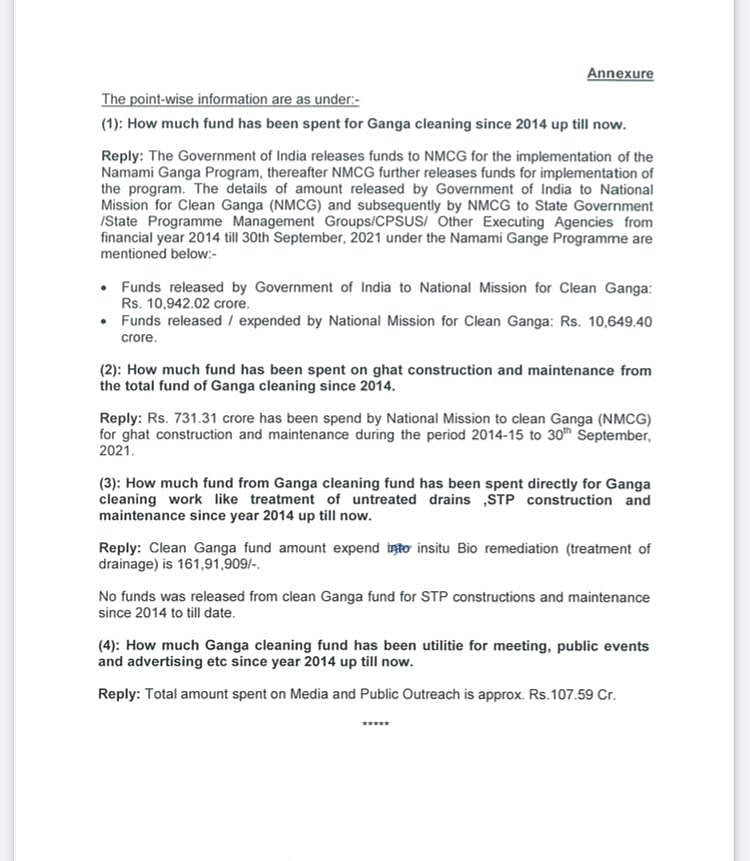Modi’s ‘Ganga aarti’ won’t cleanse river even as govt spent earmarked funds on building ghats and giving advts
In an RTI response, Centre said of Rs 10,942.02 cr allotted to National Mission for Clean Ganga, Rs 731.31 cr was spent on building/maintaining ghats and Rs 107.59 cr on ‘media and public outreach’

Even as PM Narendra Modi performed ‘Ganga aarti’ on Monday evening at Varanasi, being considered a part of his poll campaign for the assembly polls due in bellwether states including Uttar Pradesh, it has come to the fore that of the whopping Rs 10,000 crore plus his government has released to National Mission for Clean Ganga (NMCG) since 2014, over Rs 730 crore was splurged on ‘building and maintaining ghats’ and Rs 107.59 crore on 'media and public outreach'.
Moreover, hundreds of crores were spent on a technology whose efficacy is yet to be established and not a single penny was spent on construction/maintenance of Sewage Treatment Plants (STPs) which are considered to be part and parcel of river conservation efforts.
These revelations were made in an RTI response furnished by the Department of Water Resources, River Development & Ganga Rejuvenation which functions under the aegis of Union Ministry of Jal Shakti to specific queries made by Vikrant Tongad, environment conservationist and founder member of NGO Social Action for Forest and Environment (SAFE).
As per the RTI response, accessed by National Herald, the Government of India released Rs 10,942.02 crore to NMCG between financial year 2014-2015 and September 30, 2021, of which NMCG expended Rs 10,649.40.
The ministry said Rs 731.31 crore had been spent by NMCG for ‘ghat construction and maintenance’ while approximately Rs 107.59 crore was spent on ‘media and public outreach’.
Responding to a question on details of funds spent directly for Ganga cleaning work like treatment of untreated drains, STP construction and maintenance, it said Rs 161,91,909 had been spent on ‘in situ bio remediation (treatment of drainage)’ while no funds were released on construction and maintenance of STPs since 2014 to date.

Speaking to National Herald, Tongad said, “The funds earmarked to clean the Ganges should be spent on actual cleaning of the river and reviving the river rather than on peripheral activities like riverfront development."
“Moreover, more ghats will encourage more people reaching the river fronts, resulting in pollution due to open defecation and people using soaps while bathing in the river. We’re not against the idea per se. Ghats may be important in view of the spiritual connection for the people and better riverfront management. However, these can be funded from other sources and not NMCG funds,” he added.
Incidentally, a media report quoted a senior official from the ministry as saying, "All the infrastructure development, especially big ticket spends such as STPs are being carried out under the Externally Aided Projects (EAP) head. The Clean Ganga Fund is being used for other purposes."
Reacting to this, Tongad said he will be filing a first appeal to get more information on this.
Commenting on the money spent on ‘in situ bio remediation’, Tongad said, “Bioremediation is a technique that uses bacteria, fungi or other biological agents that work towards reducing toxins in the environment, in this case a polluted water body. NMCG had launched a pilot project for this some years back, but its efficacy is as-yet-undertermined.”
Noted environmentalist Manoj Misra, who served for over two decades in the Indian Forest Service before taking voluntary retirement while posted as Chief Conservator of Forest and went on to establish NGOs PEACE Institute and Yamuna Jiye Abhiyaan, was far more forthright in his comments on the issue.
“The Namami Gange programme has had serious issues right from when it was set up in 2014. Because funds were made available, and they were meant to be spent, they were spent. And where can you spend them? On construction activities…and what can you construct when it comes to rivers is ghats. It has been a story of misplaced priorities all along. It obviously helps that such activities pander to vote bank politics,” he said.
“If the secret of river rejuvenation – the avowed aim of projects like NMCG – was government funds, then there was never any dearth of such funds. It is just a very poor understanding of what a river really requires, where the priorities should lie. The moment funds are allocated, the objective gets reduced just to how much funds should be spend and on what, with the actual objective lost along the way, as in this case,” Misra said.
He said that STPs were set up using funds from other projects like JNNURM, and it was not of much concern if NMCG funds were not used for that, remarking that just setting up STPs did not actually contribute to the process of river rejuvenation. “STPs are meant to treat sewage that a city generates, river or not river. We don’t subscribe to the view that setting up STPs mean too much from the point of river rejuvenation,” he said.
Commenting on the crores spent on in situ bio remediation, Misra said, “Again, such a technology exists, but it does not address the river pollution per se but only that of the drains allowed to merge into the river. If done properly, such a technology has merit, but whether that was the case or not here, we can’t say,” he said.
“If the government was truly determined to rejuvenate the Ganges, or any other river for that matter, only two things need to be prioritised. One, all industries must have zero liquid discharge since industrial effluents are the first and foremost cause of river pollution. Second, environmental flow in the river must be ensured, that is, sufficient water must flow down its entire length rather than being diverted into canals etc. all around the year,” Misra said.
“This doesn’t need any money to be spent either. All that is needed is political will,” he said.
It may be recalled that National Mission for Clean Ganga (NMCG) was registered as a society on August 12, 2011 under the Societies Registration Act 1860 during the tenure of UPA 2 government. It acted as implementation arm of National Ganga River Basin Authority (NGRBA) which was constituted under the provisions of the Environment (Protection) Act (EPA), 1986.
The Modi govt scrapped NGRBA on October 7, 2016, replacing it with National Council for Rejuvenation, Protection and Management of River Ganga (referred as National Ganga Council), which is chaired by the PM himself.
Pollution of the Ganges, the largest river in India, poses significant threats to human health and the larger environment. The river, which is severely polluted with human waste and industrial contaminants, provides water to about 40% of India's population across 11 states, serving an estimated population of 500 million people, which is more than any other river in the world.
Today, the Ganges is considered to be the fifth-most polluted river in the world.
Follow us on: Facebook, Twitter, Google News, Instagram
Join our official telegram channel (@nationalherald) and stay updated with the latest headlines